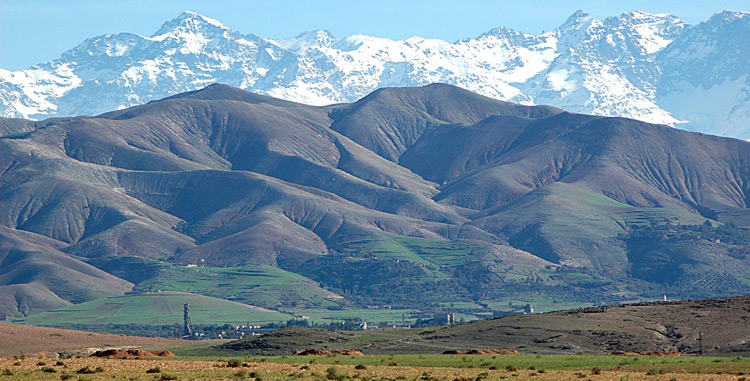|
|

|
The High Atlas, also called the Grand Atlas Mountains (Arabic: الاطلس الكبير and French: Haut Atlas) is a mountain range in central Morocco in Northern Africa.
The High Atlas rises in the west at the Atlantic Ocean and stretches in an eastern direction to the Moroccan-Algerian border. At the Atlantic and to the southwest the range drops abruptly and makes an impressive transition to the coast and the Anti-Atlas range. To the north, in the direction of Marrakech, the range descends less abruptly.
The range includes Jbel Toubkal, which at 4,167 m is the highest in the range and lies in Toubkal National Park. The range serves as a weather system barrier in Morocco running east-west and separating the Sahara's climatic influences, which are particularly pronounced in the summer, from the more Mediterranean climate to the north, resulting in dramatic changes in temperature across the range. In the higher elevations in the range snow falls regularly, allowing winter sports. Snow lasts well into late spring in the High Atlas, mostly on the northern faces of the range.
The High Atlas forms the basins for a multiplicity of river systems. The majority of the year-round rivers flow to the north, providing the basis for the settlements there. A number of wadis and seasonal rivers terminate in the deserts to the south and plateaux to the east of the mountains.
Travel over the high mountain passes is worthwhile. These striking mountains offer extremely impressive mountain biking trails, hiking trails and photography opportunities. It's a breathtaking sight that cannot be missed!
At the foot of the High Atlas one finds Aït Benhaddou, a Kasbah or castle still in use.
Among the summits at 1600 m height lies the Kasbah of Telouet on the road to Marrakech.The canyons and ravines of the Dadès and the Todra are also impressive.
The Ourika Valley runs through the Atlas Mountains, named after the Ourika River that carves it out. This is a popular summer destination, as the landscape will be green and beautiful, and quite surprising to many first time visitors to Morocco who imagine the sand dunes of the Sahara everywhere. For them, the site of this beautiful valley can be quite startling indeed! Certain roads in the Ourika Valley lead to Setti Fatma, a town famous for having seven waterfalls, and one that attracts adventurous trekkers because of the combination of natural beauty and laid back mood of the town.
The High Atlas has walks to suit all abilities, but mules and horses are also available in the villages if riding suits you better than walking. The villages in the High Atlas are small but thriving and are home to the Berbers who are enduring, hospitable and very friendly people. The villages offer stylish Moroccan accommodation in the local houses and there are established guides available. The high peaks force the clouds to give high quantities of rainfall; therefore the High Atlas has many fertile valleys surrounded by rivers and waterfalls. Mineral deposits found in the Atlas range include gold, silver, lead, iron, phosphates, lead and zinc.
|